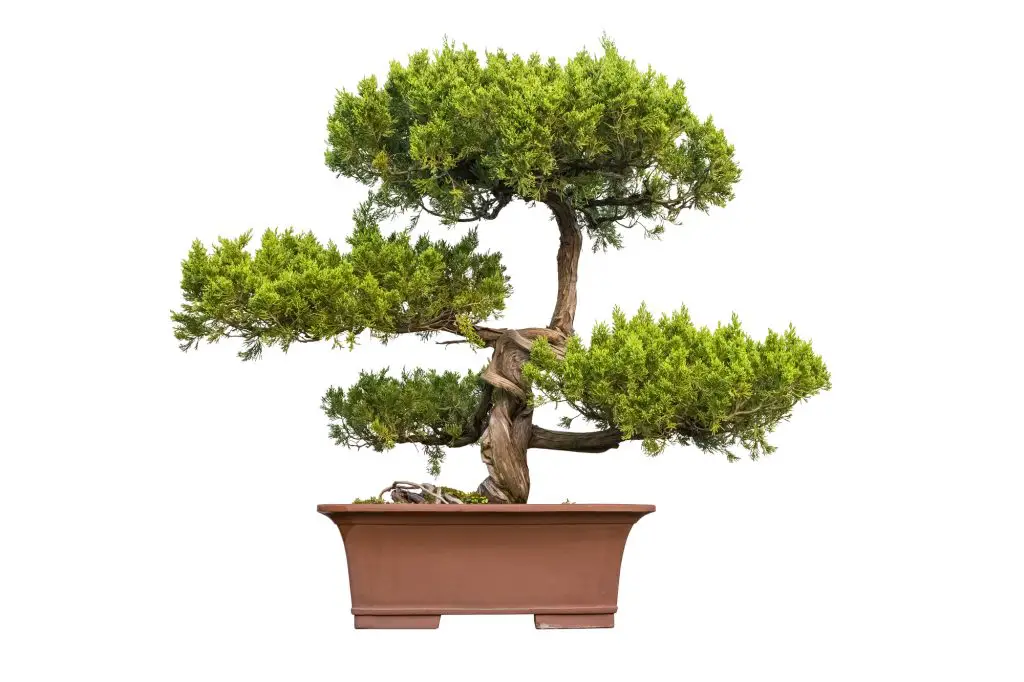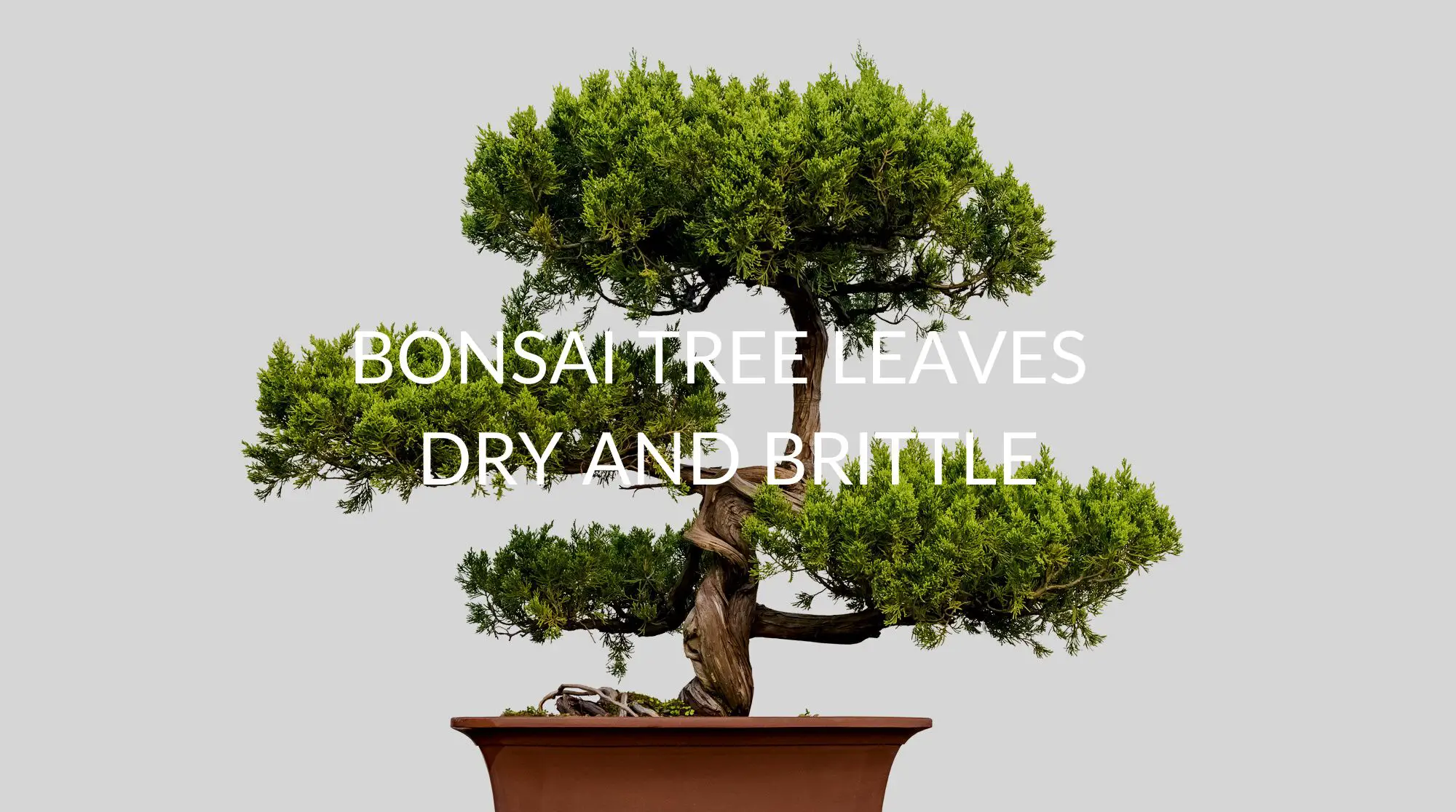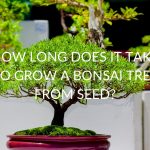Bonsai trees add a fresh source of life to any home. However, bonsais need some love and attention in order to stay healthy and keep your home feeling Zen. If your bonsai tree leaves are dry and brittle, it’ll not only be lackluster, but it means your tree is starting to die.
There are some simple solutions to salvage your bonsai if this is occurring, as well as some tips to implement into your bonsai’s routine to avoid it going dry and brittle in the future.
Why Are My Bonsai Leaves Dry?
When a bonsai’s leaves become dry, they will start to lose their luster and their color. You should hopefully notice that some of your tree’s leaves are going dry fairly quickly, so you can remedy the situation right away. However, you can’t fix it if you don’t know what’s causing your bonsai’s leaves to dry out.
Your Bonsai Isn’t Getting Enough Water
One of the main causes of a dry bonsai tree is too little water. What’s especially important is watering your bonsai enough, not giving it too much water to make up for the fact that you’ve missed some watering.
Your Bonsai Isn’t Transpiring
Transpiration is a process that bonsais undergo where water evaporates from the leaves after they get the appropriate hydration. If your bonsai isn’t getting enough water, it won’t be able to transpire. This causes your bonsai stress, which can lead to dry leaves, among other things.
Root Rot
Root rot can occur when your bonsai tree is getting too much water, and the water gets stuck within the roots. This allows the roots to build up bad bacteria and fungus, which can lead to root rot. Inadequate soil that doesn’t allow water to drain properly can also lead to root rot.
Your Bonsai Needs New Soil
If you haven’t repotted your bonsai in a while, it may need some fresh soil. Over time, soil can produce a build-up of unwanted substances such as salt, or it can lose its efficiency and nutritional value. Repotting your bonsai in fresh soil with some loam or perlite in a clean container can help water flow through the pot better, thus reviving those dry leaves.
The Room Is Drafty Or Hot
Bonsai trees can be somewhat particular in terms of the temperature and humidity levels they like. A room that is overly drafty might be too cold for your tree, which may dry out the leaves. Subsequently, a hot room may dry out the leaves and the rest of the tree, especially if it’s not being watered enough to compensate for how hot the room is.
Why Is My Bonsai Tree Brittle?
Your bonsai tree can start to feel brittle if it has been dried out for too long. Leaves will feel crispy and crunchy to the touch and may end up falling off at the slightest touch. The branches may also start to feel brittle and will become more sensitive. Below are some common causes of brittle bonsai trees.
Your Bonsai Is Root-Bound
Your bonsai tree’s roots grow outwards, and they need enough room to do so within their container. If your bonsai’s container or pot is too small, it will become root-bound. This means that the roots are congested and aren’t able to push nutrients and water through the tree efficiently.
Your Bonsai Has Been Underwatered
Not only does inadequate watering dry out your bonsai’s leaves, but over time, too little water can make your bonsai tree feel brittle. At this point, your bonsai has been going with too little water for quite some time.
Your Bonsai Has Been Overwatered
Too much water can be a bad thing for your bonsai. The key to a healthy bonsai tree is the proper amount of water. Your bonsai’s roots won’t be able to distribute the water fast enough when they are receiving too much of it. This can lead to root rot, which will end up halting water from spreading to your plant; thus, leaves will become dry and brittle.
Your Bonsai Is Getting Too Much Sun
Believe it or not, plants can get their own type of sunburn. If the sun is shining directly onto your bonsai, the heat generated can end up drying out the leaves and branches of the tree. This can lead to them feeling brittle to the touch.
The Pot Has Inadequate Drainage
Your pot needs to have more than one drainage hole, especially if you have a substantial bonsai. This will ensure your tree doesn’t get drowned in water if you’ve accidentally given them a little too much. This also allows the soil and roots to breathe and stay healthy, as too much water pooling in the pot can lead to bacteria and fungus buildup.
Here’s how you can save a bonsai tree with trunk rot:

How To Revive A Bonsai Tree With Dry And Brittle Leaves
Dry and brittle leaves aren’t always an indication that your bonsai tree is dead; there are methods you can try that help give your tree a second chance. There are no solutions to revive your tree overnight; it will take some time, but the effort is worth it to see your bonsai blossom back to vibrancy.
Mist Your Tree Occasionally
Get a spray bottle and lightly mist your bonsai tree occasionally, on top of regular watering. Misting your tree will help the tree drink up enough water to get back to normal. If you pour too much water into the soil, you may end up overwatering the tree, which won’t help.
Misting can be a good idea in the summer when humidity levels are often higher than normal. This will ensure that the heat isn’t detrimental to your bonsai’s health, as that can lead to dry and brittle leaves.
Give Your Tree A Water Treatment
Take your bonsai, still in the pot, and let it sit in a container of water. Make sure the water covers the pot, so your soil is getting nice and saturated. Let your bonsai sit in this water bath for five to ten minutes. Once you take your tree out, make sure the container is able to drain out any excess water.
Give Your Tree Bright, Indirect Sunlight
Your bonsai tree needs some sunlight to help itself regenerate back to health. It shouldn’t be getting rays directly on them by sitting in a window, as this could give your tree sunburn. Instead, it should face the window, perhaps on the opposite side of the room.
Your bonsai needs between four and six hours of indirect sunlight per day for optimal health. The sun helps leaves stay green and fresh through photosynthesis.
Change Your Bonsai’s Pot
Your bonsai should be in a pot that is fairly shallow but is wide and long enough that the tree’s roots can spread appropriately. This also gives you the opportunity to give your tree some fresh soil, which your tree will always appreciate.
Check And Prune Roots
You should take your bonsai tree out of the pot gently to see if there are any signs of root rot. Roots that are rotting will usually be slimy or squishy. If you can, gently prune those dead roots off and repot your bonsai in new, fresh soil.
Schedule Waterings
In order to avoid forgetting to water your bonsai, set reminders for yourself to check your bonsai’s soil daily and water it daily. Place your finger at least half an inch into the soil, and if it’s dry, your bonsai needs water.
Most bonsais need watering at least once a day. In warmer weather, your bonsai may need to be watered twice a day, but check the soil before giving your bonsai more water. Some bonsais may need less watering, which is why testing the soil with your finger is highly recommended.
Is My Bonsai Tree Dead If The Leaves Are Brittle?
It is possible that your bonsai tree is dead if the leaves feel dry and brittle. There is a way that you can check your bonsai to see if there’s still a chance for revival.
Take a small knife or pruning shears and make a couple of cuts on the trunk of your tree. If you are able to see a layer of green cambium under the bark, then your bonsai tree is still alive. If the layer underneath the bark is brown, then the bonsai tree has died.
If you notice that green layer, you can try to save your tree. Put it in some indirect sunlight and keep the tree and soil damp. New shoots should start to appear, though it’s not a quick process. You might have to wait a few weeks before you see signs of your bonsai coming back to life.
Should I Remove Dead Leaves From My Bonsai?
If you are able to see that your bonsai is still alive through some of the above methods, one step you can take to replenish the look of your bonsai is removing dead leaves and stems. Be sure that you do this slowly and carefully with some pruning shears. A recovering bonsai doesn’t do well being picked at a lot.
Avoid over-pruning so that you don’t end up stressing out your bonsai or accidentally removing any healthy parts of the tree. It’s best to take your time removing dead leaves. For instance, remove dead leaves that you can tell cannot be saved, then try some of the revival methods listed. After a few weeks, remove any dead leaves that couldn’t be saved through any revival methods.
Dead leaves don’t only look unsavory, but they can still take nutrients from the soil and hydration from the water even though they aren’t alive. This means that the healthy parts of your bonsai aren’t getting adequate fuel to stay healthy. These dead leaves serve no purpose, so they don’t need to stay.
Recap
If your bonsai tree leaves are dry and brittle, don’t assume it’s time to say goodbye to your tree. These trees are resilient plants and can be saved with some tender love and care. Given that, too little water is often the cause of a dry and brittle bonsai, it’s fairly simple to avoid the deterioration of your tree by scheduling watering into your daily routine.
If you keep your bonsai tree on a consistent watering schedule, give it some lovely bonsai-appropriate soil, and allow it to flourish in a sizable pot, your bonsai tree will add good energy to your home for a long while.







